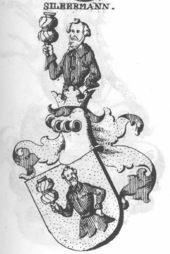Mendorferbuch Castle
The Castle Mendorferbuch is a abgegangenes Castle in the district Mendorferbuch the Upper Palatinate market Hohenburg in the district of Amberg-Sulzbach of Bavaria .
history
The Puch family was settled here. In 1142 Wolfram de Puch is named as Ministeriale of the Counts of Hohenburg . In 1170/72 the Ensdorf monastery owned property in Puch (derived from the ahd. Buoch = beech forest); this place name was extended to Mendorferbuch at the end of the 15th century by the Menderdorfer who had lived here since the 14th century . In 1243 Friedrich de Puche is mentioned, who was a judge in Hohenburg in 1257. In 1311 Frederick the Pucha sold half of the Puch castle under Hohenburg and a validity of 3½ pounds Regensburg pfennigs to Bishop Konrad of Regensburg, subject to a right of repurchase. This should have been redeemed, because later the castle no longer appears in the possession of the Regensburg bishopric .
In 1372 Chunrat der Alt, Mendorfer zu Puch, acquired the Hofmark . The Mendorfer had moved here from their headquarters in Mendorf in the Eichstätt district . In 1372 this Conrad the Mendorfer von Puch and his sons are mentioned, to whom Count Palatine Ruprecht I. owed 1000 pounds of Heller . In 1516 Hans and Sigmund Schönbüchel owned half of the Hofmark; They sell these to her brother-in-law Heinrich Muckenthaler in the same year.
In 1521 Jörg von Lichau received a guardian loan from Duke Friedrich II for Wilhelm Menderdorfer, who was still underage. His descendant Wolf Menderdorfer signed his state parliament farewell in 1544. On October 6, 1539, Wilhelm von Lichau, married to Elsbeth Mendorfer, became the owner of the Hofmark . He described himself as a subject of the Electoral Palatinate and refused to pay the Turkish tax to the Bishop of Regensburg . Wilhelm von Lichau was then taken prisoner by the bishop in Hohenburg; this called on the rulers of the Palatinate-Neuburg region, Ottheinrich and Philipp , who sent the keeper of Velburg with several mercenaries to Hohenburg to liberate the Lichau. In the 1550s should Valentin of Lichau, son of William, at Neuburg taxes and Ungeld payable; it now turned to the Regensburg Monastery for protection. The disputes ultimately went in favor of the sovereign and the Hofmark finally awarded a contract of 1602 to the Palatinate-Neuburg regional court of Burglengenfeld .

In 1592 Thomas Alkhofer (Alchover) zu Rieden acquired the Hofmark from the widow Katharina Mendorfer († 1603), whom he married on January 19, 1592. In 1603 the fiefdom was transferred to Wolf Eligius Alchover, secretary to Amberg . On January 17, 1605 the fief came to Hans Christoph von Lichau. He renovated the castle in 1615. His wife Margaretha is mentioned in 1618 as a widow. Her underage son Wolf was under guardianship. In 1642 the Hofmark went to Jörg Christoph von Silbermann , who came from Neuburg an der Donau and who had made a special contribution as a member of the Neuburg Chamber of Commerce. Other owners were: Oberwachtmeister Hans Grosch von Reichenau (1647), Rittmeister Hans von Reitz (1649), who also owned the Hammergut Leidersdorf , in 1756 the brothers Franz Egid and Josef Max von Reitz owned the Hofmarks, then Karl Theodor Freiherr von Bettschart auf Immenfeld in the Halden (1790), he was court chamber councilor and district judge in Sulzbach; He became known because he left his wife to the Bavarian Elector Karl Theodor as his lover. He thus continued a tradition of his father. He was succeeded in 1798 by Ludwig Graf von Chamisso , Knight of Honor and Electoral Chamberlain. From 1813 on, Johann Georg Freiherr von Aretin, who died in Mendorferbuch in 1845, is named here as the owner of the Hofmark.
Mendorferbuch belonged to the Amberg district court . 1802/03 Mendorferbuch is listed as a municipality in the Amberg district court. With an edict of June 7, 1818, the formation of communities was ordered, whereby the places Friebertsheim, Köstel and Lohe are counted to Mendorferbuch.
Construction
In Menderdorf there was originally a free-standing tower as the medieval seat ; As with similar buildings from the high Middle Ages, the tower will have been five storeys high, with a basement, two residential floors above, which could be reached via an external staircase, and two further storerooms and a shingle-roofed tent roof . Two buildings were later added to the tower. A small chapel stood north of the castle ensemble, the fountain and oven were east of the castle. A castle with a tower behind it is drawn on the map by Christoph Vogel from 1600. The castle was still there in 1788. In 1827 the castle chapel was converted into a barn. In the cadastre from 1830 the tower is still marked in parcel 28, in 1843 no castle is mentioned in Mendorferbuch. Probably the properties were smashed and sold individually.
literature
- Stefan Helml: Castles and palaces in the Amberg-Sulzbach district . Druckhaus Oberpfalz, Amberg 1991, pp. 153–156.
- Karl Wächter, Günter Moser: In the footsteps of knights and nobles in the district of Amberg-Sulzbach . Druckhaus Oberpfalz, Amberg 1992, p. 88.
Web links
- Werner Robl: Unknown medieval Hohenburg. Miscommunication on Hohenburg history. March 2018, accessed July 11, 2020.
- Mendorferbuch on aerial photo Laumer, accessed on July 11, 2020.
Individual evidence
- ^ Max Piendl : Duchy of Sulzbach, District Judge Office Sulzbach . Ed .: Commission for Bavarian State History (= Historical Atlas of Bavaria . Old Bavaria Series I, Issue 10). Munich 1957, p. 31 , above ( digital-sammlungen.de [accessed July 11, 2020]).
- ↑ Werner Robl: Unknown medieval Hohenburg. Mishell about Hohenburg's history , March 2018, accessed on July 11, 2020.
Coordinates: 49 ° 19 ′ 1.1 ″ N , 11 ° 50 ′ 8.5 ″ E


